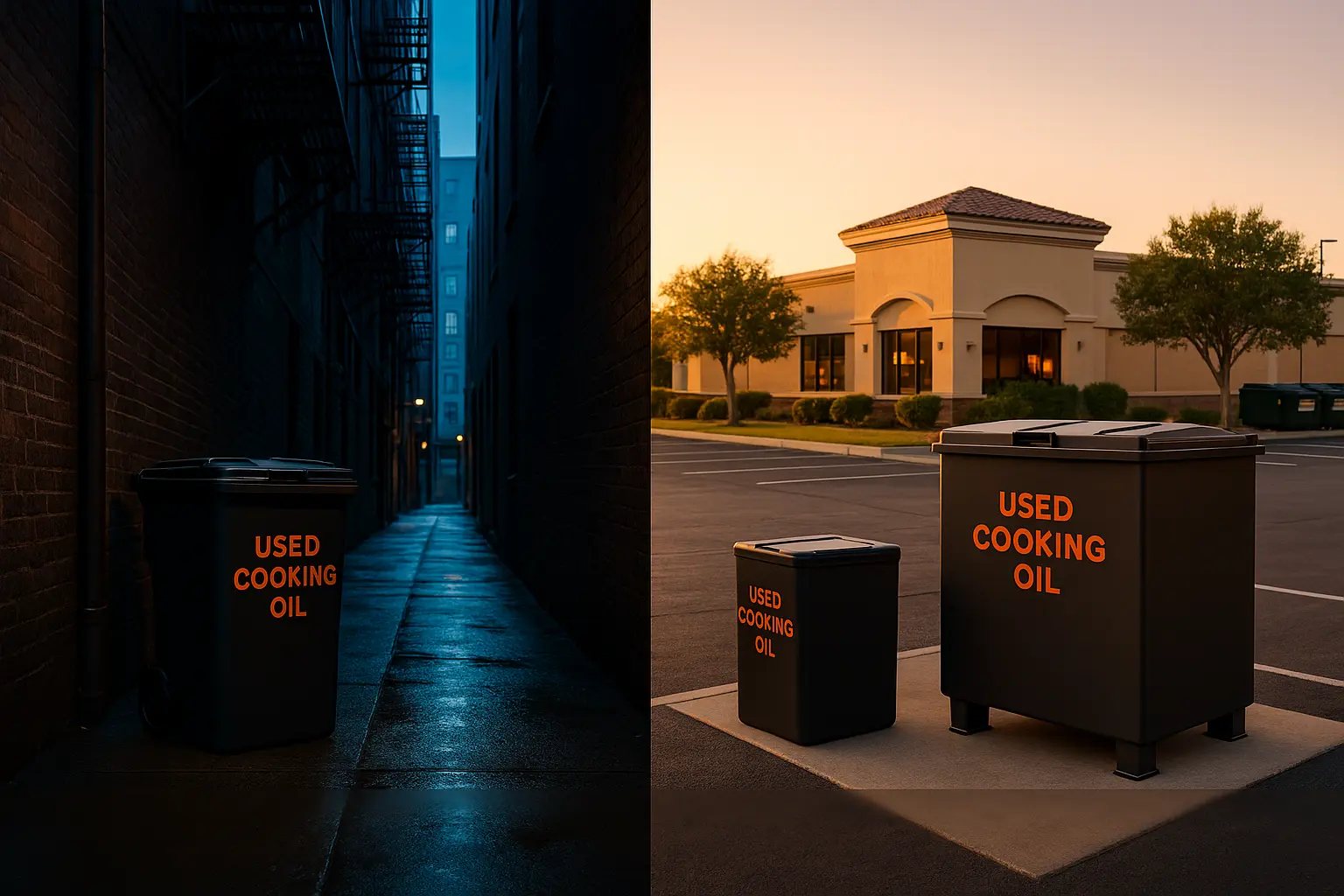Table of Contents
Why Location Shapes Your Collection Strategy
City blocks and leafy retail strips look similar on a map, yet they force haulers to design two very different playbooks. In dense urban corridors, alleys double as loading zones, valet queues, and emergency exits leaving inches, not feet, for oil collection trucks. Suburban pads, by contrast, sprawl behind drive thru lanes and dumpsters, allowing larger tanks and later pickup windows. Understanding how those physical realities cascade into cost, compliance, and employee safety is the first step toward a friction free recycling program.
Access & Pickup Logistics
Urban operators fight curb lane restrictions and early morning traffic. Most reliable haulers dispatch smaller vacuum rigs before 6 a.m., pairing GPS routing with sidewalk safe hoses to avoid blocking delivery docks. Suburban routes flex wider time windows because trucks can stage in parking lots without triggering fines. The result: urban stops average five minute dwell times, while suburban service often stretches to 15 minutes because drivers can complete pre trip safety checks onsite without drawing honks from impatient commuters. According to Grease Connections internal route timing data, alley clearances under eight feet account for 61 % of missed urban pickups proof that access planning pays.
Container Size & Placement
Space dictates hardware. City kitchens typically choose 70 gallon square caddies with lockable lids that roll through standard doorways anything larger blocks egress or violates fire codes. Suburban kitchens favour 140 gallon rectangular tanks on skids, or even 300 gallon wheeled totes for commissaries, because there’s room to position them behind bollards in illuminated corners of the lot. According to Allied Renewal’s placement guidelines, proper lighting and a poured concrete pad cut spill incidents by 30 %.
Compliance & Permitting Nuances
Urban restaurants answer to stricter municipal FOG ordinances that bundle oil storage rules with grease trap inspections. Miami Dade’s manual, for instance, requires spill proof connectors and manifest logs kept on site for three years. Suburban jurisdictions lean on state health codes but rarely mandate electronic manifests yet county fire marshals may inspect secondary containment during dumpster walks. Operators switching from one environment to the other must update permits and ensure their hauler uploads pickup certificates directly to the city portal to avoid “no show” fines.
Service Frequency, Volume & Pricing
| Factor | Urban Collection | Suburban Collection |
|---|---|---|
| Typical container | 70 gal caddy (lockable) | 140 gal tank or 300 gal tote |
| Average pickup window | 4 6 a.m., Tue Sat | 8 a.m. 3 p.m., Mon Fri |
| Volume per stop | 35 75 gal | 75 200 gal |
| Fee model* | Flat service + theft insurance | Rebate above 100 gal/mo |
| Common surcharges | Alley obstruction, after hours | Long hose (>50 ft) |
Technology & Monitoring
Smart tanks level the playing field. Ultrasonic sensors text haulers at 75 % capacity, preventing overflow tickets in urban cores where inspectors patrol alleys weekly. Suburban clients use the same IoT dashboards to postpone pickups until fryer oil turnover peaks often around holiday catering seasons cutting carbon miles by 18 %. Integrating sensor data with cloud manifests also satisfies auditors in one click, a must for multi unit brands juggling city and county regulators.
Environmental & Community Impact
A gallon of grease kept out of storm drains saves roughly two thousand gallons of potable water from contamination, yet theft rings still siphon millions in high value oil from unlit suburban lots. Urban sites, meanwhile, risk overflows that send oil straight into combined sewers during heavy rain. Choosing sealed, monitored containers and locating them behind cameras turns sustainability pledges into measurable community wins.
Choosing the Right Partner
Ask any hauler about footprint, permitting support, and theft mitigation in one breath; a true partner answers with route maps, compliance contacts, and lock specs, not a generic brochure. Grease Connections offers hurricane rated tanks, bilingual 24/7 dispatch, and direct ACH rebates services calibrated for both Brickell high rises and Atlanta strip malls. Book a free site audit and we’ll recommend the container, pickup cadence, and permit checklist that lets you focus on food, not FOG.









